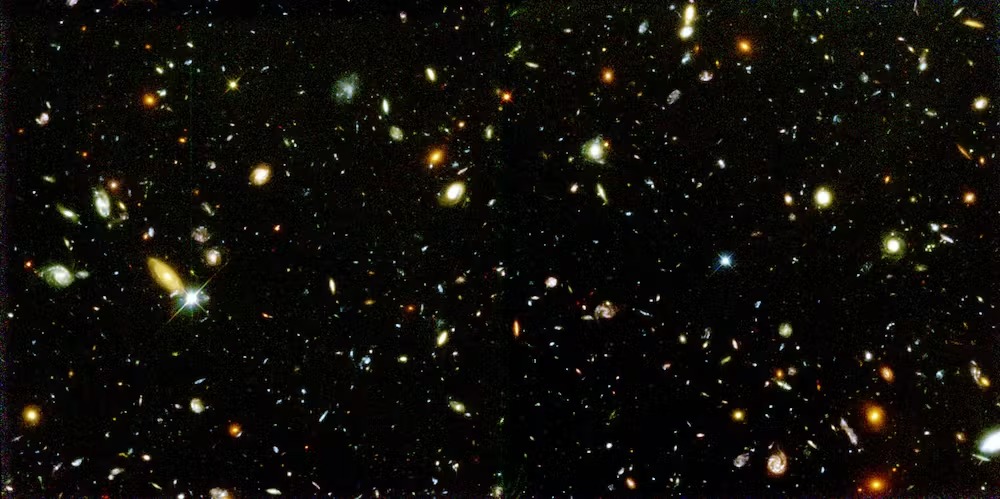
Scientists have been aware for many years that the universe is expanding. When they use powerful telescopes to look at distant galaxies, they notice they are getting farther and father away from our own planet. For scientists, the light a galaxy emits has a longer wavelength when the galaxy is speeding away from us.
The farther the galaxy, the more its light shifts towards the longer red side of the spectrum. This shift is called redshift; the higher it is, the farther away the galaxy moves.
Because light doesn’t travel instantly but at a fixed speed, looking at something far away means we’re seeing it as it was in the past. When we look at far-off galaxies with high redshift, we’re basically peeking into the universe’s earlier days. Hence, high redshift is related to the universe’s earlier times, while low redshift refers to later times.
Expansion speeding up due to dark energy
As they’ve dug into these far-off spaces, astronomers have detected something surprising. It’s not just that the universe is getting bigger. It is actually speeding up in its expansion. The speed of this growth is even faster than what any theory has determined it should be. This has scientists scratching their heads and searching for novel explanations.
Scientists have labeled the force resulting in this acceleration as “dark energy,” but they are not entirely sure how dark energy operates.
However, they believe its behavior might be clarified by something called a cosmological constant. This constant is a feature of spacetime that plays a role in the universe’s expansion.
General relativity theory
Albert Einstein first introduced this constant, marking it with the symbol lambda in his general relativity theory. With a cosmological constant, as the universe expands, the energy density of this constant remains unchanged.
Think of a box filled with particles. If the box grows, the particles spread out, and their density decreases. Now, picture the same box, but particle density stays the same as it expands.
It might not sound straightforward. The idea that the energy density of the cosmological constant doesn’t drop as the universe gets bigger is indeed a bit strange. However, this peculiar characteristic actually helps make sense of why the universe is speeding up in its expansion.
Lambda CDM theory
Presently, the leading cosmological theory, known as Lambda CDM, takes center stage. “Lambda” refers to the cosmological constant linked to dark energy, and “CDM” represents cold dark matter. This model explains the universe’s acceleration in its later stages and the early expansion rate.
Specifically, Lambda CDM clarifies observations of the cosmic microwave background. This background is the lingering glow of microwave radiation from the universe’s hot, dense phase around three hundred thousand years after the Big Bang.
28 billion light years away…
That’s how far away the star Earandel is from us.
But the universe is 13.8bn years old, how can the distance be 28bn light years?
Well, Hubble’s Law.
The universe is expanding at a rate faster than light.
This is why at the end of the… pic.twitter.com/fufyxuM8UC
— Linus (●ᴗ●) (@LinusEkenstam) August 11, 2023
The Planck satellite, dedicated to measuring the cosmic microwave background, played a key role in shaping the Lambda CDM model. By applying the Lambda CDM model to the cosmic microwave background, physicists can forecast the Hubble constant’s value. Interestingly, the Hubble constant isn’t truly constant. It’s a measurement depicting the current rate of the universe’s expansion.
However, the Lambda CDM model isn’t flawless. Based on observations of the cosmic microwave background, the expansion rate calculated by measuring galaxy distances doesn’t match up with the rate described in Lambda CDM. Astrophysicists refer to this mismatch as the Hubble tension.
Hubble tension
In recent years, the focus has been on exploring ways to unravel the mystery behind Hubble tension. This tension suggests that the Lambda CDM model might be incomplete, urging physicists to adjust their understanding or even develop entirely new concepts about the universe. For physicists, the prospect of new ideas is always thrilling.
One approach to addressing Hubble tension involves tweaking the Lambda CDM model, particularly by altering the expansion rate in the late stages of the universe at low redshift. This modification allows physicists to anticipate the kinds of physical factors that might be contributing to Hubble tension. For example, it could be that dark energy isn’t a constant but a result of gravity behaving in novel ways.
The latest research indicates that simply adjusting the expansion rate in the late universe as part of this solution approach doesn’t fully account for Hubble tension. This entire category of solutions falls short in explaining observed discrepancies.
See all the latest news from Greece and the world at Greekreporter.com. Contact our newsroom to report an update or send your story, photos and videos. Follow GR on Google News and subscribe here to our daily email!



